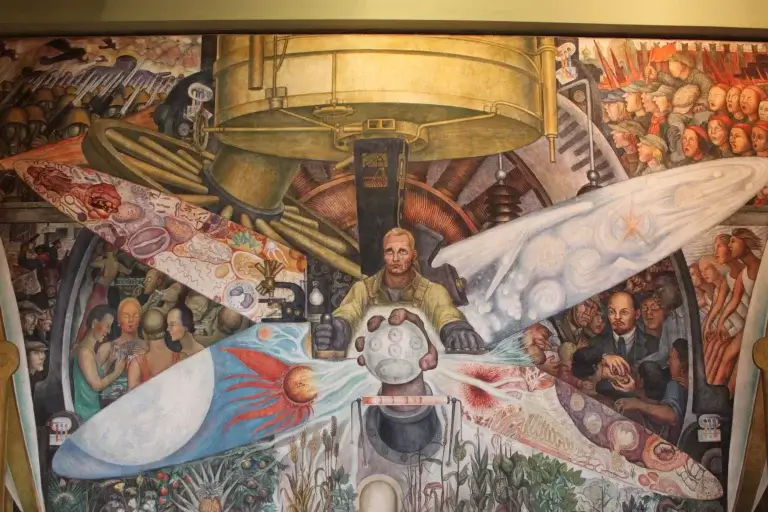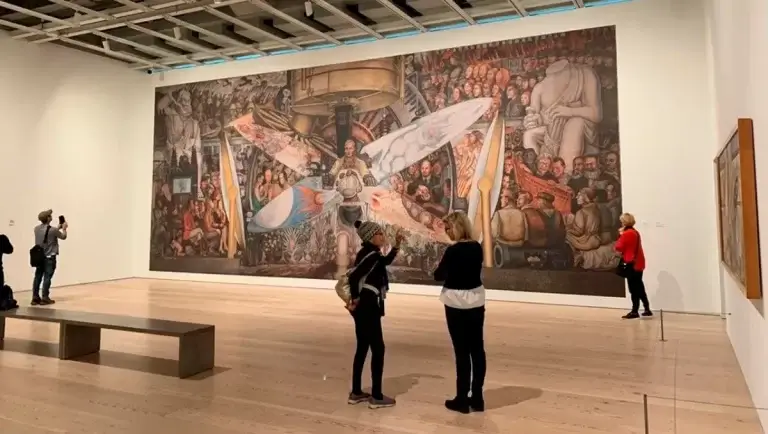
Latin American Muralism
Latin American Muralism: Art as a Political Instrument
Latin American Muralism was born in 1910 after the Mexican Revolution as a way of political expression. It was driven by political activists of the time and developed by groups of young artists.
Muralism has been a way of expressing through art an opposition to the dictatorships and violent regimes that have characterized Latin American political history. In these murals, social problems are captured in images, he moves away from the traditional art academy and aims to raise a discontent and protest by creating monumental public domain to challenge the aristocratic art to which only a few had access.
Its boom, undoubtedly, occurred in Mexico around the 1920s, where after a revolution, the facades of government buildings were the center of demonstrations by means of these murals. But more than showing disagreement, Muralism took on a role of educating the masses by recreating the country’s history.
Some of the exponents who contributed to the development and evolution of this movement are:
Diego Rivera: His murals at the Palacio Nacional de Bellas Artes in Mexico City initiated this movement that was later continued by José Clemente Orozco, David Alfaro Siqueiros, among others. He used to touch, in his works, on anti-capitalist themes and support for workers’ movements. He proclaimed himself a revolutionary in the eyes of the world for his mural at the Rockfeller Center in New York in which he portrayed Lenin and Stalin, which had to be removed immediately.

David Alfaro Siqueiros: Throughout his artistic career he chose to create murals that stood out as experimental and innovative. He traveled throughout South America and established the principles of Latin American Muralism in other countries as well. In his works, he played with perspective, angles and implemented documentary photography as part of the movement.
José Clemente Orozco: In the interwar period, he contributed great creations to Mexican pictorial art. He was recognized as an interpreter between revolution and Art.
Even so, muralism gained strength not only in Mexico but also in other countries in Latin America, who opted for it as a need to express their revolution through an artistic manifestation.
In Chile, muralists emerged after Allende’s triumph with propagandistic messages about the responsibilities of the State and its citizens. There it was not developed by individual artists, but by brigades.
In Brazil, issues of high social importance such as racism, indigenous communities and poverty were discussed. It became popular in the streets of the different neighborhoods and favelas also as a means of expression for love of country and freedom in society.
Ecuador took muralism as a movement of historical recreation. Subsequently, the government embraced this historical practice and gave way to great artists such as Diógenes Paredes, Jaime Valencia and José Enrique Guerrero, Oswaldo Guayasamín and Galo Galecio to intervene in important places and buildings in their cities. These artists had a notorious historical and pictorial influence of the Mexican muralists.
In Colombia, muralism was immediately rejected by politicians and academics, but it would later become a movement much mentioned and loved by them. The most important muralists were inspired by the history of the country, its social problems and urban legends and myths.
It didn’t take long for this movement to spread beyond Latin America either, initially by Latin American migrants who through their murals showed their identity as immigrants and the convergence and clashes of various cultures.
Muralism currently maintains its importance, museums around the world exhibit its works and stories and throughout Latin America buildings, libraries and facades of works by its greatest representatives are preserved.





- April 15, 2025
Gallery Of Painting By Matt Rota - USA

- April 15, 2025
Gallery Of Illustration By Egle Plytnikaite - Lithuania

- April 15, 2025
Gallery Of Humor Drawing By Pierre Ballouhey - France

- April 14, 2025
Gallery of Illustration by Ananda Ferreira – Brazil


- April 14, 2025
Gallery of Illustration by Luis San Vicente – Mexico

- April 14, 2025
Analysis of Artistic Works Created with…

- April 13, 2025
From Digital Art to Contemporary Art

- April 13, 2025
The Expansion of Photography

- April 12, 2025
When is photography considered art?

- April 10, 2025
Impact of AI on the Diversity of Artist…

- April 10, 2025
How can AI enhance artistic creativity?

- April 09, 2025
The Impact of Artificial Intelligence o…

- April 08, 2025
Latin American art, a goldmine of oppor…

- April 07, 2025
Contemporary Art in Brazil: Between the…

- April 07, 2025
Mexican Muralism: Art for the People

- April 06, 2025
History of graphic art in Brazil

- April 05, 2025
Modern Art: A Renaissance in Art History

- April 02, 2025
Aldo Estrada (Ilustronauta): From Peruv…

- March 31, 2025
How ChatGPT is Turning Photos into Japa…

- March 30, 2025
Arístides Hernández (ARES): A Sharp Min…

- March 30, 2025
The Masters of Cuban Caricature: Celebr…

- March 29, 2025
Where Will Artificial Intelligence Take…

- March 27, 2025
A Few Fascinating Features of Latin Ame…

- March 27, 2025
9 Key Books to Understand Latin America…

- March 26, 2025
The Underground: A Glimpse into 1930s L…

- August 29, 2023
The history of Bolivian art

- February 19, 2024
Analysis and meaning of Van Gogh's Star…

- January 28, 2024
Culture and Art in Argentina

- September 25, 2023
What is the importance of art in human …

- September 23, 2023
What is paint?

- August 30, 2023
First artistic manifestations

- August 10, 2023
14 questions and answers about the art …

- August 23, 2023
The 11 types of art and their meanings

- March 26, 2024
The importance of technology in art1

- August 16, 2023
The 15 greatest painters in art history

- September 23, 2023
History of painting

- April 06, 2024
History of visual arts in Ecuador

- January 20, 2024
What is the relationship between art an…

- March 26, 2024
Cultural identity and its impact on art…

- January 31, 2024
Examples of Street Art – Urban Art

- April 07, 2024
Graffiti in Latin American culture

- October 21, 2023
Contemporary art after the Second World…

- September 23, 2023
Painting characteristics

- August 25, 2024
A Comprehensive Analysis of the Cartoon…

- August 08, 2023
Cultural Diversity in Latin American Art

- February 19, 2024
Analysis and meaning of Van Gogh's Star…

- August 13, 2023
9 Latino painters and their great contr…

- August 29, 2023
The history of Bolivian art

- August 10, 2023
14 questions and answers about the art …

- January 28, 2024
Culture and Art in Argentina

- August 23, 2023
The 11 types of art and their meanings

- November 06, 2023
5 Latin American artists and their works

- September 23, 2023
Painting characteristics

- August 27, 2023
15 main works of Van Gogh

- September 23, 2023
What is paint?

- September 25, 2023
What is the importance of art in human …

- August 30, 2023
First artistic manifestations

- January 20, 2024
What is the relationship between art an…

- December 18, 2023
10 iconic works by Oscar Niemeyer, geni…

- January 12, 2024
10 most beautiful statues and sculpture…

- October 30, 2023
Characteristics of Contemporary Art

- March 26, 2024
Cultural identity and its impact on art…

- August 22, 2023
What are Plastic Arts?

- April 16, 2024
The most important painters of Latin Am…

- October 11, 2023


